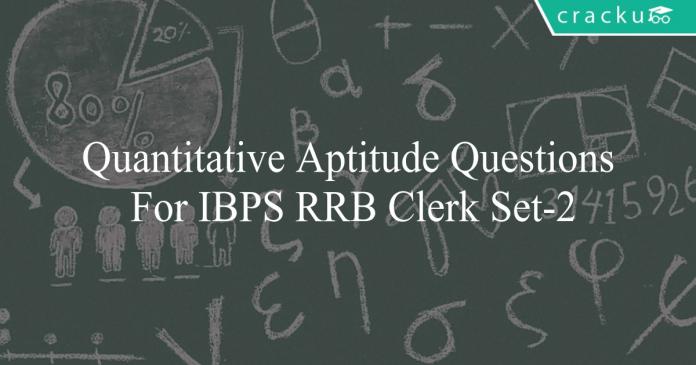Quantitative Aptitude Questions For IBPS RRB Clerk Set-2
Download Top-20 IBPS RRB Clerk Quantitative Aptitude Questions PDF. Qunatitative Aptitude questions based on asked questions in previous year exam papers very important for the IBPS RRB Assistant exam
Download Quantitative Aptitude Questions For IBPS RRB Clerk Set-2
35 IBPS RRB Clerk Mocks @ Rs. 149
70 IBPS RRB (PO + Clerk) Mocks @ Rs. 199
Take a free mock test for IBPS RRB Clerk
Download IBPS RRB Clerk Previous Papers PDF
Question 1: In a constituency there are 3 contestants A,B, C and a total of 2,00,000 votes are present in which the winning candidate ‘A’ scored the same number of votes equal to the other two candidates if 10% of votes are invalid and the ratio of votes received by C and B is 1:2. Total number of votes received by ‘B’ is ?
a) 10000
b) 15000
c) 45000
d) 60000
e) 30000
Question 2: A person eats 60% of the apples he brought and throws away 15% of the apples and after a week he again eats 50% of the remaining apples and throws away 20% of the apples and the next week he eats the remaining apples.If the total apples thrown away is 500 then what is the number of apples that he had eaten ?
a) 1600
b) 1800
c) 2000
d) 1500
e) 1700
Question 3: A pattern of numbers is in the form of 2,3,1,4,0,5,-1,6,-2,….. What is the average of first 20 terms of the given pattern ?
a) 0
b) 0.75
c) 2.50
d) 1.50
e) 3
Instructions
Directions (16 – 20): Study the table below and answer the questions that follow:

Note: Some values are missing. You need to calculate them according to the given data.
Question 4: What is the average time taken(in seconds) by all the trains to cross the man if the time taken by B and D to cross the platforms is 5 seconds and 9 seconds respectively?
a) 3
b) 4
c) 2
d) 5
e) None of these
Question 5: What is the time taken by Train A to cross the platform if the length of the platform which A crosses is 25 metres more than the length of the platform which E crosses?
a) 9 seconds
b) 12 seconds
c) 11 seconds
d) 13 seconds
e) None of these
Question 6: What is the difference between the time taken by the trains B and D to cross the man if the time taken by B and D to cross their platforms are 5 seconds and 9 seconds respectively?
a) 3 seconds
b) 2 seconds
c) 1 second
d) 4 seconds
e) None of these
Question 7: A man has 2 sons and the ages of them are 12 years and 15 years.He deposits total of Rs 3,60,000 in the bank for a time period that is until any one of them reaches 18 years and the money is deposited in the ratio of their present ages.What is the difference between the total amount they receive after the stipulated time if rate of interest is 5% simple interest ?
a) 24000
b) 28000
c) 40000
d) 32000
e) 36000
Question 8: A person purchases 200 apples at Rs 300 per dozen.He sold 40% of the apples at Rs 30 per each apple and 25% of the remaining apples were spoiled and in the remaining apples half were sold at Rs 40 per each and the other half were sold at 35 per each. Find the profit/loss percent
a) 24.5%
b) 24%
c) 24.7%
d) 24.8%
e) 25%
Question 9: A trader got 10%,20% and 30% profit by selling three article A,B and C respectively.If the sum of cost price by A and B is twice that of C and the difference between the cost price of A and B(A>B) is 40% of the cost price of A. What is the overall profit of the trader ?
a) 60.2%
b) 60.8%
c) 60.4%
d) 60.6%
e) 70%
Question 10: If the ratio of investments of Ram, Ravi and Ramesh are in the ratio of $\frac{1}{5}$ : $\frac{2}{3}$ : $\frac{3}{2}$ and they invested for 100/7%, $\frac{3}{2}$%, $\frac{5}{2}$% respectively of their investment, and the profit of C is 178 then what will be the profit of A?
a) 760
b) 775
c) 700
d) 288
e) 322
Free Mock Test for IBPS RRB Clerk
IBPS RRB Clerk Previous Papers
Question 11: A solution contains three different liquids X,Y and Z in the ratio 5:7:4. If liquids X and Y are added to it so that the resultant solution has X,Y and Z in the ratio 3:2:1 then in which ratio X and Y are added to the solution ?
a) 7:1
b) 7:2
c) 5:1
d) 5:2
e) 6:1
Question 12: A solution contains 3 liquids A,B and C.The ratio of volumes of B and C is 7:2.It contains 15 litres of A.If 5 litres of B and 4 litres of C is replaced by equal volumes of A then the ratio of volumes of A and B becomes 4:5. What is the total volume of the solution?
a) 60 litres
b) 50 litres
c) 45 litres
d) 30 litres
e) 70 litres
Question 13: The ratio of 3rd and 6th term of a GP is 27. If the first term of the GP is 10, then find out the sum of infinite terms of this convergent GP.
a) 30
b) 40
c) 15
d) 20
e) 25
Question 14: Sum of the first 3 terms of an AP is 2/9 times the sum of first 6 terms of the same AP. Find out the ratio of first term to the common difference of the same AP.
a) 3 : 8
b) 1 : 4
c) 2 : 7
d) 1 : 3
e) 1 : 5
Question 15: N is a number that leaves the same remainder on dividing 2527, 2419, 2383, and 2599. The largest value of N that satisfies the condition is
a) 54
b) 18
c) 72
d) 36
e) 90
Instructions
In each of the following questions a question is asked followed by three statements.You have to study the questions and all the given three statements and all the statements and decide whether any information provided in the statement are redundant and can be dispensed with while answering the questions ?
Question 16: What will be the cost of the painting the four walls of a room with length ,width and height is 5,3,8 meters respectively. The room has one window and one door.
I.Cost of painting per square meter is Rs 25
II.Area of window is 2.25 sq m which is half of the area of the door
III.Area of the room is 15 sq meter
a) I only
b) II only
c) III only
d) II or III only
e) All are required to answer the question
Question 17: How much time will the train X take to cross another train Y running in the opposite direction ?
I.Train X crosses a signal pole in 6 secs
II.Ratio of the speeds of trains X and Y is 3:2
III.Length of the two trains together is 500 meters
a) I only
b) II only
c) III only
d) I or II only
e) Data inadequate
Question 18: Three friends X,Y,Z started a partnership business investing money in the ratio of the 5 :4:2 respectively for a period of 3 years.What is the amount received by X as share in the total profit ?
I.Total amount invested in the business is Rs.22,000
II.Profit was distributed after a period of 2 years
III.The average amount of profit earned per year is Rs 2,750
a) I only
b) II only
c) III Only
d) I and II only
e) I or II or III
Question 19: The sum of ages of father and his daughter is 45 years. If the product of their ages 8 years ago was 3 times the age of the father at that time. What will be the age of father after 4 years?
a) 27 years
b) 38 years
c) 11 years
d) 34 years
e) 31 years
Question 20: Srinivas is four times as old as his daughter. Five years ago, Srinivas was nine times as old as his daughter was at that time. His daughter’s present age is:
a) 10 years
b) 8 years
c) 6 years
d) 5 years
Quantitative Aptitude formulas PDF
520 Banking Mocks – Just Rs. 499
Answers & Solutions:
1) Answer (D)
Total number of valid votes=200000*(0.9)
=180000
Given A=B+C
Therefore A+B+C=180000
A+A=180000
2A=180000
A=90000
Given B/C=2/1
B=2C
B+C=90000
B+(B/2)=90000
3B/2 =90000
B=30000*2
B=60000
2) Answer (C)
let the total number of apples be ‘p’
In the 1st week he ate 0.6p and thrown away 0.15p
Therefore after 1st week apples left=p-(0.6p+0.15p)
=0.25p
In the second week he ate 0.125p and thrown away (0.25)*(0.2)*p=0.05p
Therefore after 2nd week apples left=0.25p-(0.125p+0.05p)
=0.25p-0.175p
=0.075
Total apples eaten =0.6p+0.125p+0.075p
=0.8p
Total apples thrown away=0.2p
Therefore 0.2p=500
p=2500
Total apples eaten =0.8*2500
=2000
3) Answer (C)
Here the pattern consists of 2 different series in AP
i.e 2,1,0,-1,… and the other 3,4,5…..
10th term in 2,1,0,-1,… is -7
10th term in 3,4,5….. is 12
Sum of 1st series is 3-((7*8)/2)=3-28=-25
Sum of 2nd series is (12(13)/2)-3=78-3=75
Sum=50
Average=50/20
=2.5
4) Answer (B)
Let the length of the train B be $T_B$ metres
Length of the platform which B crosses = 210 metres
Time taken to cross the platform = 5 seconds
Speed of train B = 252 km/hr = $252\times\dfrac{5}{18} = 70$ m/sec
$\dfrac{T_B + 210}{5} = 70$
=> $T_B + 210 = 350$
=> $T_B = 140$
Therefore, Length of the train B = 140 m
Then, Time taken by train B to cross the man = $\dfrac{140}{70} = 2$ seconds
Let the length of the train D be $T_D$ metres
Length of the platform which D crosses = 200 metres
Time taken to cross the platform = 9 seconds
Speed of Train D = 144 km/hr = $144\times\dfrac{5}{18} = 40$ m/sec
$\dfrac{T_D + 200}{9} = 40$
=> $T_D + 200 = 360$
=> $T_D = 160$
Therefore, Length of the train D = 160 metres
Time taken by the train D to cross the man = $\dfrac{160}{40} = 4$ seconds
Therefore, Average time taken by all the trains to cross the man = $\dfrac{6+2+3+4+5}{5} = \dfrac{20}{5} = 4$ seconds
5) Answer (D)
Speed of train A = 198 km/hr = $198\times\dfrac{5}{18} = 55$ m/sec
Length of train A = 55*6 = 330 m
Length of platform which A crosses = 360+25 = 385 metres
Then, Time taken by A to cross the platform = $\dfrac{330+385}{55} = \dfrac{715}{55} = 13$ seconds.
6) Answer (B)
Let the length of the train B be $T_B$ metres
Length of the platform which B crosses = 210 metres
Time taken to cross the platform = 5 seconds
Speed of train B = 252 km/hr = $252\times\dfrac{5}{18} = 70$ m/sec
$\dfrac{T_B + 210}{5} = 70$
=> $T_B + 210 = 350$
=> $T_B = 140$
Therefore, Length of the train B = 140 m
Then, Time taken by train B to cross the man = $\dfrac{140}{70} = 2$ seconds
Let the length of the train D be $T_D$ metres
Length of the platform which D crosses = 200 metres
Time taken to cross the platform = 9 seconds
Speed of Train D = 144 km/hr = $144\times\dfrac{5}{18} = 40$ m/sec
$\dfrac{T_D + 200}{9} = 40$
=> $T_D + 200 = 360$
=> $T_D = 160$
Therefore, Length of the train D = 160 metres
Time taken by the train D to cross the man = $\dfrac{160}{40} = 4$ seconds
Therefore, Required difference = 4-2 = 2 seconds.
7) Answer (B)
From the given information the time period is 18-15=3 years
So the money is distributed in the ratio 4:5 i.e On 1st son it is (4/9)*360000=160000
On the second son it is (5/9)*360000=200000
Interest for 1st son=160000*3*5/100
=24000
Interest for 2n son=200000*3*5/100
=12000
Amount received by 1st son=160000+24000
=184000
Amount received by 2nd son=200000+12000
=212000
Difference=212000-184000
=28000
8) Answer (A)
Given CP per dozen=300
For each apple cost=300/12
=Rs 25
Total cost price of apples=200*25
=5000
He sold 40% of apples at Rs 30 per each
So (40/100)*200 =80 apples
80*30=Rs 2400
25% of remaining apples are spoiled i.e (3/5)*(1/4)*120=18 apples
So total leftover apples=120-18
=102
So 51 apples are sold at 40 per each and the other 51 apples at 35 per each
Therefore total CP=51*40+51*35
=2040+1785
=Rs 3825
Total CP=3825+2400
=6225
Profit percent=((6225-5000)/(5000))*100
=1225/50
=24.5 %
9) Answer (B)
Let the cost price of A,B and C be a,b and c
SP of A=1.1a
SP of B=1.2b
SP of C=1.3c
Total SP=1.1a+1.2b+1.3c
Total CP=a+b+c
Aso given a+b=2c
a-b=0.4a
b=0.6a
a+b=2c
1.6a=2c
c=0.8a
Total SP=1.1a+1.2(0.6a)+1.3(0.8a)
=1.1a+0.72a+1.04a
=3.86a
Total CP=a+0.6a+0.8a
=2.4 a
Total profit percent=((3.86a-2.4a)/(2.4a))*100
=60.8%
10) Answer (D)
The ratio of profit is given by,
= $(\frac{1}{5} \times \frac{1}{5} \times \frac{1}{7}) : (\frac{2}{3} \times \frac{2}{3} \times \frac{3}{200}) : (\frac{3}{2} \times \frac{3}{2} \times \frac{5}{200})$
= $\frac{1}{175} : \frac{1}{50} : \frac{9}{160}$
The profit of A =
11) Answer (A)
Let the initial volumes of X,Y and Z be 5x,7x and 4x respectively
Now let ‘a’ amount of X is added to the solution
Let ‘b’ amount of Y is added to solution
Let the final volume of each liquid X,Y and Z be 3y,2y and y respectively
As the volume of Z is not changed we have 4x=y
New volume of X=5x+a
New volume of Y=7x+b
Therefore we have 5x+a=3y
5x+a=12x
a=7x
7x+b=2(4x)
b=8x-7x
b=x
Ratio of a:b=7:1
12) Answer (A)
Let the initial volumes be A,B and C
A=15 litres
B=7x and C=2x
A=15+5+4=24 litres
B=7x-5
C=2x-4
Given 24/(7x-5)=4:5
120=28x-20
28x=1440
x=5 litres
B=7(5)-5=30 litres
C=2(5)-4=6 litres
Total volume=24+30+6=60 litres
13) Answer (C)
Let ‘r’ be the common ratio of the given GP.
The ratio of 3rd and 6th term of a GP is 27.
$\dfrac{ar^2}{ar^5}$ = 27
$\Rightarrow$ $\dfrac{1}{r^3}$ = 27
$\Rightarrow$ $r = \dfrac{1}{3}$
Sum of infinite GP = $\dfrac{a}{1-r}$ = $\dfrac{10}{1-1/3}$ = 15
Hence, option C is the correct answer.
14) Answer (E)
Let ‘a’ and ‘d’ be the first term and common difference of the given AP.
$\Rightarrow$ $\dfrac{3}{2}(2a + 2d) = \dfrac{2}{9}[\dfrac{6}{2}(2a + 5d)]$
$\Rightarrow$ $3a+3d = \dfrac{2}{3}(2a + 5d)$
$\Rightarrow$ $9a+9d = 4a + 10d$
$\Rightarrow$ $5a = d$
$\Rightarrow$ $\dfrac{a}{d} = \dfrac{1}{5}$
Therefore, option E is the correct answer.
15) Answer (D)
N leaves the same remainder on dividing 2527, 2419, 2383, and 2599, the difference between any pair of these numbers should be divisible by the number. The smallest difference will be the limiting factor.
2599 – 2527 = 72
2599- 2419= 180
2599-2383= 216
2527- 2419= 108
2527- 2383= 144
2419- 2383= 36
As we can see, 36 is the smallest difference and hence, the largest number that satisfies the given condition is 36.
Therefore, option D is the right answer.
16) Answer (C)
Length = 5 m , Breadth = 3 m and Height = 8 m
To find the cost of painting the walls of the room, we should know the cost of painting and the area of door and window.
Area of 4 walls (Curved Surface Area of cuboid) = $2h(l+b)$
= $(2 \times 8)(5+3) = 16 \times 8 = 128$ $m^2$
From I & II : Cost = Rs 25 per square meter
Area of window = $2.25$ $m^2$
and Area of door = $2 \times 2.25 = 4.5$ $m^2$
Thus, area to be painted = $128 – 2.25 – 4.5 = 121.25$ $m^2$
$\therefore$ Cost of painting 4 walls = $25 \times 121.25 = Rs$ $3031.25$
Thus, statement III is redundant.
=> Ans – (C)
17) Answer (E)
To find the time taken by train X to cross train Y, we should know the sum of speed of the trains (as they are moving in opposite directions) and the sum of lengths of the train
In statement II, ratio of speed of train X : Y = 3 : 2
Thus, we cannot find the speeds of the two trains.
$\therefore$ Data is inadequate
=> Ans – (E)
18) Answer (D)
Ratio of investment of X : Y : Z = 5 : 4 : 2
To find the share of profit earned by X (or anyone), we need to find the total profit earned.
From statement III : Average profit for 3 years = Rs. 2750
=> Total profit = $2750 \times 3$ = Rs. 8250
Amount received by X = $\frac{5}{(5+4+2)} \times 8250$ = Rs. 3750
Thus, statements I and II are redundant.
=> Ans – (D)
19) Answer (B)
Let the present age of father be ‘f’ and the daughter be ‘d’
As per the given question,
f + d = 45 ….(1) and
(f – 8)(d – 8) = 3(f – 8)
Substitute equation (1) in the above equation
(f – 8)(37 – f) = 3(f – 8)
37 – f = 3 (or) f = 34
The age of the father after 4 years will be 34 + 4 = 38 years.
Hence, option B is the correct answer.
20) Answer (B)





